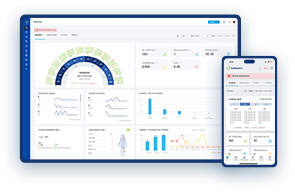
Incident vs Near-miss vs Observation: Key Safety Insights
Understanding the nuances of workplace safety is fundamental in any industry. Key terms like incidents, near-misses, and observations are often used, but what do they really mean? This blog post aims to clarify these concepts. We’ll delve into their definitions and distinguish how each plays a vital role in building a safer work environment.
Understanding Incidents, Near-misses, and Observations
Each term – incidents, near-misses, and observations – plays a pivotal role in the tapestry of workplace safety. Here’s a closer look at what each means and why they matter.
Incidents:
An incident is a realized event that leads to injury, damage, or loss in the workplace. Ranging from minor mishaps to severe accidents, these occurrences highlight immediate safety breaches and areas needing corrective action.
Imagine a worker in a factory slips on a wet floor and sprains an ankle. This is an incident, as it’s an event where an injury has occurred. It prompts immediate attention and highlights a need for preventive measures, like better signage for wet floors or more timely clean-up procedures.
Near-misses:
A near-miss is a fortuitous escape. It represents an event that could have resulted in harm but didn’t, serving as a critical learning opportunity to preempt future incidents.
Consider a scenario where a heavy tool almost falls from a shelf but is caught just in time by a passing worker. No one is injured, but it was a close call. This near-miss signals a potential risk (unsecure tools on shelves) that could have led to an injury, indicating the need for corrective actions like securing tools more effectively.
Observations:
Observations involve actively spotting unsafe practices or conditions before they escalate. These proactive measures are key in preventing potential incidents or near-misses, emphasizing a culture of safety vigilance.
Suppose during a routine inspection, an employee notices that a fire extinguisher is blocked by boxes. No incident or near-miss has occurred yet, but this observation of a blocked safety equipment is crucial. It allows for proactive measures to ensure the extinguisher is accessible in case of an emergency, thereby preventing potential future incidents.
Key Differences among Incidents, Near-misses, and Observations
While incidents, near-misses, and observations are intertwined in the fabric of safety management, understanding their differences is crucial for effective risk mitigation and prevention strategies.
Outcome and Impact:
The most striking difference lies in their outcomes. Incidents result in actual harm or loss, making them reactive in nature. Near-misses, on the other hand, are incidents that fortunately didn’t result in harm but had the potential to do so. They serve as proactive warnings. Observations are entirely proactive, identifying risks before they materialize into near-misses or incidents.
Response and Management:
The response to each also varies. Incidents typically require immediate action and often a detailed investigation to prevent recurrence. Near-misses demand analysis to understand and mitigate the risks that nearly led to harm. Observations involve regular monitoring and preemptive actions to improve safety conditions.
Role in Safety Culture:
Each plays a different role in fostering a safety culture. Incidents often trigger reviews of safety policies and emergency response protocols. Near-misses are vital for safety training and education, highlighting what could go wrong. Observations are the bedrock of a proactive safety culture, encouraging continuous vigilance and improvement.
Recognizing these differences helps in tailoring specific strategies for handling each scenario. It enhances the overall effectiveness of safety management systems, like Safetymint, in creating a safer and more responsive work environment.
Reporting and Documentation: Pillars of Effective Safety Management
Accurate reporting and meticulous documentation are essential in distinguishing and managing incidents, near-misses, and observations. This process not only ensures compliance but also enhances safety practices.
Incidents:
When an incident occurs, it’s crucial to document every detail immediately. This includes the nature of the incident, the individuals involved, the extent of harm or damage, and the circumstances leading up to the event. This documentation is vital for legal compliance, insurance purposes, and to develop strategies to prevent future incidents.
Near-misses:
Reporting near-misses is often overlooked, yet it’s equally important. Documenting these events helps in identifying potential hazards before they result in real harm. It involves recording the nature of the near-miss, conditions at the time, and any immediate corrective actions taken. This fosters a learning culture that proactively addresses safety risks.
Observations:
Documenting safety observations involves keeping a record of potential hazards and unsafe practices. It’s about creating a log of regular checks and the safety issues identified during these checks. This proactive approach not only helps in immediate risk mitigation but also aids in long-term safety planning and policy formulation.
Improve safety reporting with Safetymint
Safetymint’s Incident Management module streamlines this process, offering a structured and efficient way to report and document these varied safety aspects. With comprehensive reporting tools, available both on web and mobile, it becomes easier to analyze trends, understand the root causes of incidents, and implement preventive measures.
Experience Safetymint with a 14-day free trial.

Ramesh Nair is the Founder and Principal Partner of Niyati Technologies, the company behind Safetymint.
He’s a dedicated advocate for workplace safety. Ramesh firmly believes that every individual deserves to return home safely after a day’s work. Safetymint, the innovative safety management software, emerged from this conviction. It’s a platform designed to streamline safety management, empower safety professionals, and enhance safety in workplaces.
Through his blog, Ramesh shares insights, best practices, and innovative solutions for workplace safety. Visit his social media profiles to follow him for regular updates.




